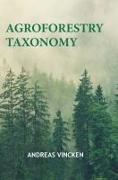Read more
The taxonomy of agroforestry has greatly evolved over time, adapting to the changing needs and understanding of the practice. In the early stages, agroforestry systems were broadly classified into simple and complex systems. Simple systems involved the integration of a few tree species with crops or livestock, while complex systems involved a higher degree of diversity and interactions among multiple tree species, crops, and livestock. As research and knowledge in agroforestry expanded, more detailed taxonomies were developed to capture the intricate relationships and functions within these systems. The taxonomy considers factors such as tree-crop interactions, spatial arrangement, management practices, and ecological functions. Agroforestry systems can now be classified into categories such as alley cropping, silvopasture, windbreaks, home gardens, and among others.
This book Agroforestry Taxonomy emphasizes the importance of systematic classification and organization of agroforestry practices. The taxonomy presented in the book not only categorizes different agroforestry systems but also provides a nuanced understanding of the ecological, economic, and social dimensions associated with each category.

